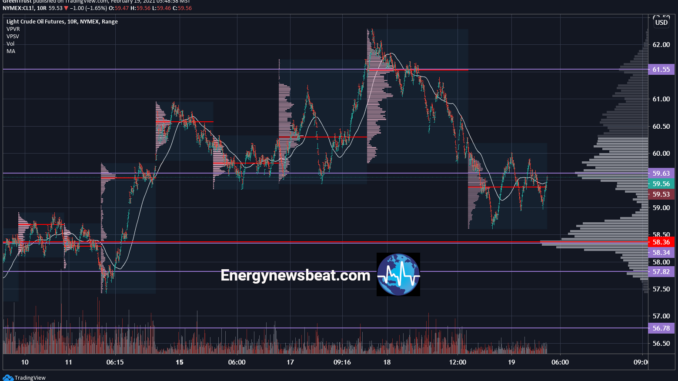
New York — 0308 GMT: Crude futures weakened during midmorning trade in Asia Feb. 19 as the support received from supply disruptions in the US due to freezing temperatures eased, allowing prices to return to fundamental values, market sources said.
At 11:08 am Singapore time (0308 GMT), the ICE April Brent contract was down $1.39/b (2.17%) from the Feb. 18 settle at $62.54/b while the NYMEX March light sweet crude contract fell $1.54/b (2.54%) at $58.98/b.
The US Energy Information Administration’s weekly inventory report released late Feb. 18 estimated a 7.3 million barrel draw in crude inventories the week ended Feb. 12. The EIA also reported a 3.4 million draw in distillate inventories and a smaller-than-expected build of 700,000 barrels in gasoline inventories over the same period.
Despite the report seemingly signaling a bullish sentiment, price reaction was tepid as markets focused on adjusting for recent gains that came on the back of temporary supply disruptions in parts of the US.
“Oil prices are coming off the boil as the power crisis spurred on by the massive winter storm is starting to ebb … the market will now be more inclined to shift back to regular supply and demand fundamentals,” said Stephen Innes, chief global markets strategist at Axi, in a Feb. 19 note.
Warmer and milder temperatures are expected to return by Feb. 20, in the US, according to the US National Weather Service.
“As support from the wintery weather in US eases, traders are eager to take profit off the table before the weekend, resulting in the pullback,” told David Lennox, resource analyst at Fat Prophets, to S&P Global Platts on Feb. 19.
Despite the recent easing in oil prices, analysts agreed the current levels still reflect the fundamental support the market is receiving from a recovering demand outlook and supply discipline from the OPEC+ alliance.
All eyes are on the next OPEC+ meeting on March 4, where the group is expected to discuss April production quotas. Given the strength in oil prices despite the recent pullback, some analysts said the odds of easing supply restrictions are increasing.
“Oil may cool slightly on this news [of easing supply curbs], but there is nothing here that should be a cause for concern. Saudi Arabia and OPEC+ will continue to be responsive to macro conditions and manage supply through what remains a period of uncertainty on demand,” said Innes.
Rollbacks in productions quotas are expected to be conservative, as the alliance remains cognizant of the fragile state of demand recovery.
“Even before the the weather related disruptions in the US, shale production was not increasing significantly despite high oil prices, showing that the threat of US shale producers ramping up production was not severe. As we are still in the early days of vaccine-backed economic recovery, the alliance will likely keep production levels stable,” said Lennox.



